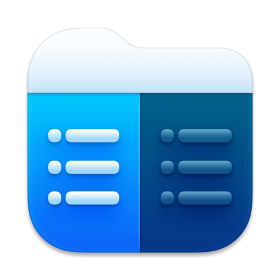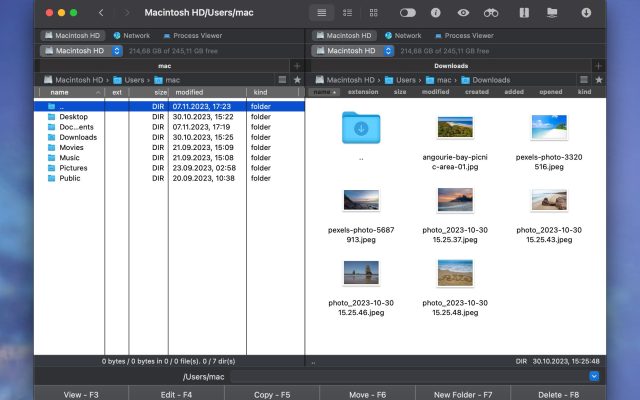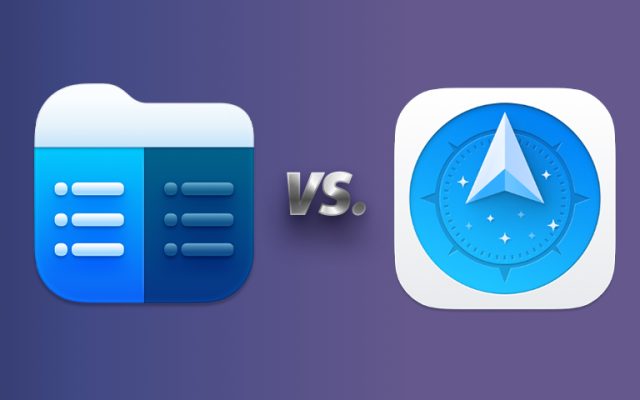- File manager for Mac
- What is the perfect Total Commander for Mac solution?
What is the perfect Total Commander for Mac solution?
One of the most common problems faced when switching from the Windows operating system to the Apple platform is finding a Mac Total Commander alternative. Despite the native app called Finder is a great file manager it lacks the necessary features to meet all the requirements of the users. There are quite a lot of two-panel file managers for macOS, but in our opinion, the best Total Commander Mac alternative is the file manager Commander One.
Users situation:
I'm used to working with windows, recently acquired a mac, and although a lot of the stuff is smarter. I still miss Total Commander like I have been used to working with. Any suggestions?— Reddit
Commander One – Total Commander alternative
After having a quick look at Total Сommander, let’s examine its alternative, namely Commander One. Quite a lot of Mac users call Commander One the perfect Total Commander alternative for Mac and you can tell it by opening it as when you launch the app and look at its interface the classic two-pane file manager comes into view.
When working with files very often the users move, copy, delete items and so they have to open Finder twice in order to perform this routine.

To open any device, click on the arrow at the top of one of the panels, and you will see a list of available media. Select a drive or storage device from the list and it will open in the panel above which you clicked the button. Now you can quickly browse and find the file that you want to move from one location to another. Otherwise, if you did not have this file manager installed, you would have first to open two folders, and then browse the first one and then the second to find the desired document.
There are only ten buttons on the top panel of this Total Commander Mac solution and all of them are important and necessary – you will use them constantly, so it will not be difficult to get used to them. These buttons are divided into three sections and they are responsible for:
- Choosing the type of file viewing on the specified panel.
- File Actions: View hidden files Mac, properties of a selected file, folder or file information, and start a search.
- Archiving, FTP server connection, and cloud data storage.
At the bottom of the program there are six buttons with the most common commands: view, edit, copy, move, create a new folder, and delete.
As you can see, all the main functions are available with one click of the mouse in this Total Commander alternative – and you will not spend a lot of time getting used to them. You can also call all Commander One functions using hotkeys – their list is available in the application settings and, as provided by the developers, they are all customizable.
What are Commander One features
- Unlimited number of open individual tabs in Commander One panels.
- Mark only those files with which you want to work.
- Ability to rename a file while moving or copying it.
- Scheduling file operations, especially those that can take a long time (for example, copying large files).
- Advanced file system search with RegExp support. Commander One allows you to search for any files and folders in your Mac’s file system, even if the files are in archives. You can also use regular expressions for a more precise search.
- Content search. Even if you do not remember the name of the document you are looking for, you always have the opportunity to search for words that may be in this document with fairly flexible search settings.
- Spotlight search function is available in the advanced search section.
- Support for ZIP, 7ZIP, TGZ, TBZ, tar.bz2 (tbz2, tb2), tar.Z, tar.lzma and tar.xz, RAR (opening mode only) archiving.
- Built-in file viewer (similar to Finder).
- Support for cloud storage and remote servers. Ability to mount them as local drives.
- Ability to mount Android, iOS, and MPT devices.
- Terminal emulator.
- Root access, which makes it possible to change access rights to files and folders.
- Ability to download various color themes.
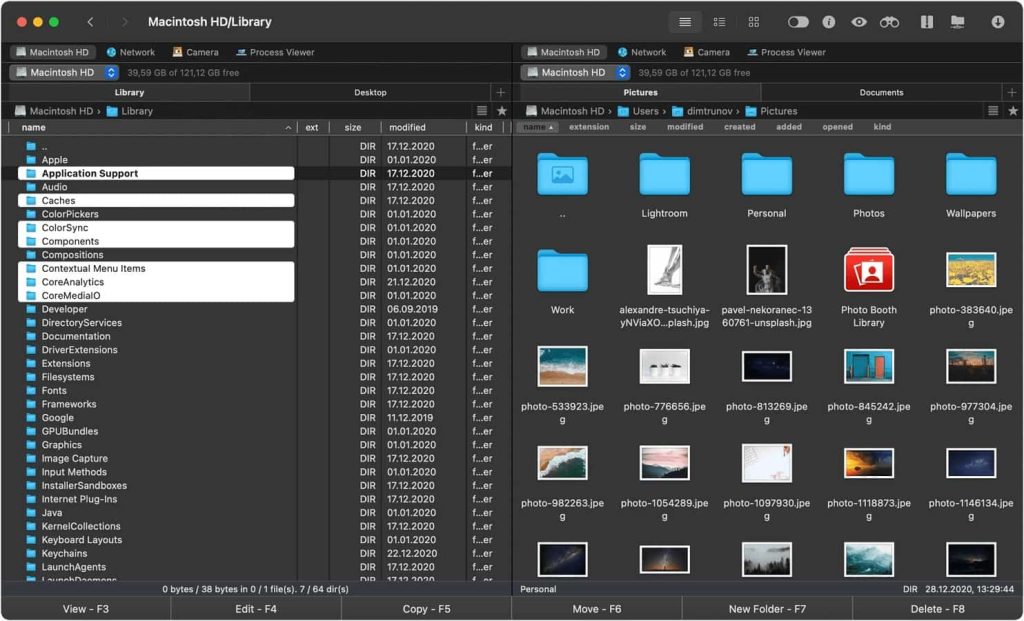
As you can see, this Total Commander for Mac alternative really got a huge number of features. In its basic version, Commander One is distributed completely free of charge, but the developers also offer to purchase an extended version of their application. Unlike the basic version, Commander One Pro contains several additional and extremely useful functions for more advanced users.
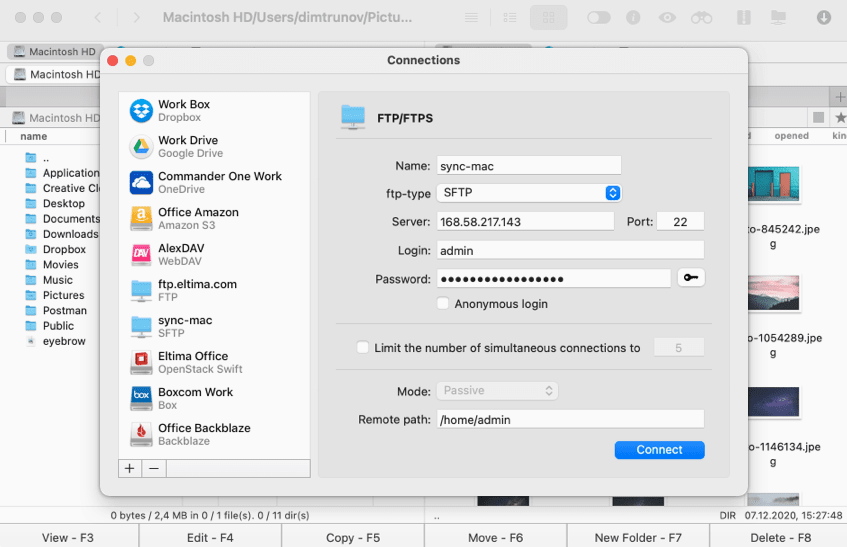
As we all know, features are an integral part of any software. Without the right set of user-friendly features, the software would be useless. The good news is that Commander One is loaded with all the essential features you would want from a good file manager software. It should also be borne in mind that the quality of features is always better than the number of features.
History of Total Commander file manager
First of all, let’s plunge a little into the history of the creation and development of this file manager, and see how from such initially not very pretty manager appeared such a brilliant solution. In general, the idea of a two-window version was implemented almost at the dawn of the era of computers. Probably, some of the readers still remember Norton Commander, which was for many a window into the file world of Dos. Namely from this file manager, all programs, games and other things were opened as well as files were copied, deleted, replaced, and moved by the users those days. The two-window mode of operation was very convenient and did not require the use of a mouse to perform various operations, since the corresponding hotkeys were assigned for this.
Do you know why Total Commander evokes so many enthusiastic feedback from those users who could understand it? The answer is simple, it allows you to save time on routine operations (we most often save, copy, delete or move objects or folders on a computer) and besides, it makes it possible in two clicks to do what you could only dream of, seeing the powerlessness of File Explorer when dealing with dozens of tasks.
What is Total Commander or formerly Windows Commander?
So, the first release of the Total Commander file manager was released back in 1993. Then the program had another name, namely Windows Commander. The developer of this application is the Swiss programmer Christian Giesler, who is updating the program to this day. Since 2002, the file manager has been renamed to the name we know today – Total Commander. In addition to performing the usual actions with various files and folders, starting from version 4, new opportunities became available to the user – installing plugins and changing the program interface. And for more than three decades now, it has very firmly taken a leading position in its niche.
During this time, a lot of Total Commander alternatives and clones of the app appeared (it is worth mentioning the fact that among which there are many free distributions), which were no worse, and in some places even better than the original, but due to the reasons given below, the original is still ideal for many.
Mainly, it is determined by the power of habit, however, the main factor of such vitality was the presence of a huge number of plugins/add-ons for the file manager, which allow you to implement an unimaginably wide range of tasks using Total Commander file manager. Besides that, both newbies and incredibly smart programmers will find something interesting for themselves among the plugins.

What is Total Commander used for?
Total Commander literally means that you get “total control” or “complete control”. This is the essence of the Total Commander file manager – it is needed to manage the file system of various devices. For example, you can control your computer, or removable media, or even use an application to upload files to a remote server. It cannot be said that without this program your computer will disappear, but with Total Commander, it will be much easier and more convenient to perform various operations.
Many people use this particular program, and not the standard Windows Explorer because by default the computer takes a long time to perform operations, and Total Commander works quickly. You can copy, move, rename, cut, and paste almost instantly any files that you have access to. Your computer will quickly turn into an orderly system along with the Total Commander file manager. Although at first, it may seem to you that using the manager is not very convenient, over time you will get used to it, and you will understand that there are many advantages to it.
Total Commander file manager features
Wondering what the program can do? Let’s talk about the main functions of Total Commander:
- Convenient utility interface for users. The Total Commander file manager’s control panel is divided into two windows, which makes it convenient to work in it.
- The program has the ability to view any files. To do this, press the “F5” key.
- It can cut and collect so-called “heavy files”.
- Knows how to pack files into an archive and unpack them. Supports such formats as ZIP, RAR, ARJ, GZIP, TAR, LZH, ACE, 7zip, and many others.
- Multi-tasking file search engine that includes text search in any file, including multiple disks and FTP; search for copies of files; search within archives is organized; search by matching text in a file.
- Built-in file browser to view files of any size in binary, hexadecimal, or text format using various encodings including “DOS”, “ANSI” / “Windows”, Unicode, UTF-8, and others; the ability to use a large number of different editors.
- Total Commander can be configured at your discretion, there are many settings, names but a few.
- Many key combinations (so-called hotkeys) for editing, viewing, copying, and deleting files (full keyboard control without using a mouse has been initialized).
- Sorts files on the computer.
- Renames files and folders in groups, deletes files, creates directories. Moves files from one drive to another, for example, from drive C to drive D.
- Knows how to synchronize directories of files and folders.
In addition, the Total Commander file manager can connect to an FTP server, which allows you to connect your computer and the hosting site. Of course, these are not all the features of the program. We went through only at the ones that are often used by users.
What are the disadvantages of Total Commander file manager
As a rule, there is no such thing as an ideal application and Total Commander is not an exception. So let’s check its negative sides:
- Constant pop-up demand for an unregistered version about the need to pay for it.
- Supports work only with Windows or Android operating systems.
As you can see, Total Commander is a multifunctional file manager designed to satisfy the requests of almost any user. The functionality of the program can be expanded even more with the help of constantly updated plugins.
Conclusion
We know that many of you might be wondering why you need a file manager if your Mac already has one. As we explained earlier, the default file manager or Mac Finder is not that detailed in terms of management. Many core features are missing by default, and until now, there has been no word from Apple about adding these features to the software. However, the good news is that you still have great alternatives that you can use.
Commander One is one of the best alternatives available on the market and the excellent Total Commander alternative for those who got used to Windows and finding it hard to switch to Mac. Of course, there are countless options available, but finding the right one is absolutely essential and Commander One is the best choice you can make.
Total Commander for Mac: Frequently Asked Questions
The first version of Commander One was released on the 4th of August 2015. The app is constantly updating as deemed appropriate by the developers.
You can send your feature requests and suggestions at support@electronic.us. Our development team is taking into account all your wishes as we want our software to be perfect and convenient for your use.
Despite being a good file manager, Finder doesn’t support two-pane mode and lacks some important features.
There are a lot of pug-ins for Total Commander file manager, but they can be divided into several categories, namely:
- Archiving. It’s clear what they are for.
- Systemic. Provides access to those directories that cannot be reached by conventional means.
- For the internal viewer. Show special file types in the built-in viewer or on the Quick Access Toolbar.
- Informational. With their help, you can find out all the ins and outs about files, rename them, split them by tags and get information about their contents.
- Quick search plugins. Changes the encoding and algorithms of the built-in quick search to improve it.

